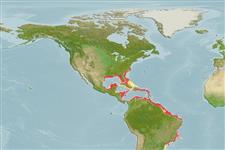>
Eupercaria/misc (Various families in series Eupercaria) >
Gerreidae (Mojarras)
Etymology: Diapterus: Greek, di = two + Greek, pteron = wing, fin (Ref. 45335).
More on author: Cuvier.
Environment: milieu / climate zone / depth range / distribution range
Écologie
marin; saumâtre démersal; profondeur 9 - 70 m (Ref. 9626). Tropical; 35°N - 30°S, 97°W - 32°W
Western Atlantic: southern Gulf of Mexico, Central America and the Antilles to Brazil (Ref. 9626).
Length at first maturity / Taille / Poids / Âge
Maturity: Lm ?, range 13 - ? cm
Max length : 42.3 cm TL mâle / non sexé; (Ref. 122735); common length : 30.0 cm TL mâle / non sexé; (Ref. 3722); poids max. publié: 76.30 g (Ref. 118626)
Common in mangrove-lined lagoons; also found over shallow mud and sand grounds in marine areas. Juveniles common in hypersaline lagoons and in brackish water (Ref. 5217). Probably feeds on small benthic invertebrates. Marketed fresh but not highly esteemed. Minimum depth from Ref. 26912.
Life cycle and mating behavior
Maturité | Reproduction | Frai | Œufs | Fécondité | Larves
Randall, J.E. and R. Vergara R., 1978. Gerreidae. In W. Fischer (ed.) FAO species identification sheets for fishery purposes. Western Central Atlantic (Fishing Area 31). Vol. 2. pag.var. (Ref. 3722)
Statut dans la liste rouge de l'IUCN (Ref. 130435: Version 2024-1)
Menace pour l'homme
Harmless
Utilisations par l'homme
Pêcheries: intérêt commercial mineur
Outils
Articles particuliers
Télécharger en XML
Sources Internet
Estimates based on models
Preferred temperature (Ref.
123201): 23.5 - 28, mean 26.5 °C (based on 288 cells).
Phylogenetic diversity index (Ref.
82804): PD
50 = 0.5625 [Uniqueness, from 0.5 = low to 2.0 = high].
Bayesian length-weight: a=0.01202 (0.01023 - 0.01413), b=3.03 (2.98 - 3.08), in cm total length, based on LWR estimates for this species (Ref.
93245).
Niveau trophique (Ref.
69278): 3.0 ±0.2 se; based on diet studies.
Résilience (Ref.
120179): Milieu, temps minimum de doublement de population : 1,4 à 4,4 années (Preliminary K or Fecundity.).
Fishing Vulnerability (Ref.
59153): Low to moderate vulnerability (32 of 100).
Nutrients (Ref.
124155): Calcium = 250 [121, 570] mg/100g; Iron = 1.95 [0.84, 4.31] mg/100g; Protein = 18.5 [16.4, 20.6] %; Omega3 = 0.184 [0.077, 0.438] g/100g; Selenium = 119 [47, 317] μg/100g; VitaminA = 2.59 [0.55, 10.82] μg/100g; Zinc = 1.62 [0.94, 2.72] mg/100g (wet weight);
